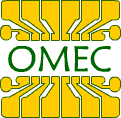Photovoltaics
Converting sunlight into power
Every day more energy on the form of sunlight falls on the earth than we use in an entire year. For this green energy source to replace fossil fuels, however, we urgently need low cost solar cells to convert sunlight into useful electrical power…
In 2008, OMEC was awarded £1.8 M by the Engineering and Physical Sciences Research Council to produce a scaleable, technology for the fabrication of organic photovoltaic devices. The grant brings leading research groups from Universities around the country to tackle the pressing problem of creating efficient, low-cost, photovoltaic devices that can convert sunlight into useful electrical power economically. The approach to solving this problem being developed in the OMEC consortium is based on our extensive knowledge of conjugated polymers in electronic applications. Essentially we wish to create low-cost plastic sheeting that can capture sunlight…

Conjugated polymers are the key component of a plastic solar cell, and the task of synthesising these is split between Chemistry groups in Manchester and Sheffield [1,2]. Work at these groups will include the preparation, purification and chemical evaluation of the polymers that will be used in the solar cells.

Synthesis is only part of the story, however, to get acceptable device performance the micro- and nano-scale structures of these polymers will have to be carefully evaluated and controlled. Techniques including SAXS/WAXS, AFM, SNOM, electron and confocal microscopy will all be employed at Sheffield [3] to assist the characterisation of the morphological structure of the phase-separated polymer blends.
Scientists at Imperial College [4] will subsequently use the knowledge of the polymer’s properties to construct and optimise working solar cells. Here the dynamics of photogenerated charges will be evaluated using transient optical spectroscopies, spectroscopic ellipsometry, photovoltaic device fabrication, and charge lifetime monitoring.
Finally, at Durham [5], scientists will attempt to correlate the properties of the solar cells with the underlying morphologies and polymer types into a coherent theoretical model. This multiscale modelling will be used to understand device performance. Providing new theoretical leads to improving and optimising the devices.
Participating groups in OMEC:
- Prof. Michael Turner and Dr Brian Saunders, University of Manchester
- Dr Ahmed Iraqi and Prof. Tony Ryan, University of Sheffield
- Profs. Tony Ryan and David Lidzey, University of Sheffield
- Prof. Jenny Nelson and Dr Saif Haque, Imperial College
- Dr Nigel Clarke, University of Durham

News